
The Solar-Terrestrial Centre of Excellence (STCE) is a collaborative network of the Belgian Institute for Space Aeronomy, the Royal Observatory of Belgium and the Royal Meteorological Institute of Belgium.
 |
Published by the STCE - this issue : 4 Apr 2014. The Solar-Terrestrial Centre of Excellence (STCE) is a collaborative network of the Belgian Institute for Space Aeronomy, the Royal Observatory of Belgium and the Royal Meteorological Institute of Belgium. |
| Archive of the newsletters | Subscribe to this newsletter by mail |
Homologous flares are the solar equivalent of identical twins. They concern a series of solar flares taking place repetitively in the same active region with essentially the same position and with a common pattern of development, i.e. having the same main footpoints and general shape in the main phase as defined in H-alpha or EUV-imagery. Though not a requirement, homologous flares often have similar strength, and if there are more than two, they sometimes occur within similar time intervals.

A good example occurred on 24-26 November 2000, when five homologous X-class (!) flares were produced by active region NOAA 9236 southwest of its main leading spot (image above). Note in the middle image, there's a difference of 5 hours between SOHO's EUV image and the continuum on which it is overlaid. The study of this kind of flares is important as it might provide information on flare trigger mechanisms, as well as on the processes of energy storage and release. Hence, these studies may offer vital clues for improving space weather forecasts.

Last week, moderately sized sunspot region NOAA 2017 produced 1 X- and 3 M-class flares within less than 48 hours (see image above). On 28 March, there was an M2.0 flare (peak at 19:18UT) followed a few hours later by an M2.6 flare (peak at 23:51UT). One day later, an X1.0 flare peaked at 17:48UT, and on 30 March there was an M2.1 flare hitting its maximum at 11:55UT. The flares occurred near a delta region to the north and east of the main spot (image underneath). A delta concerns spots of opposite polarity within the same penumbra and within 2.5 degrees from each other (more info at http://stce.be/news/222/welcome.html).
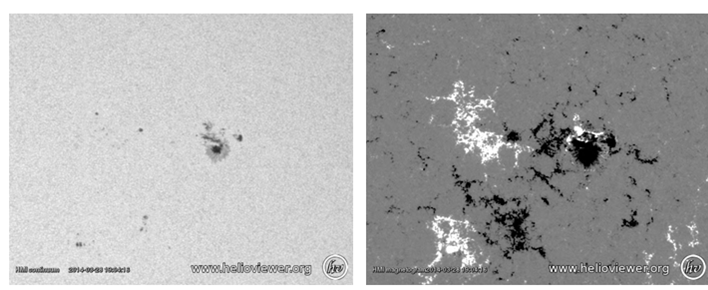
A preliminary analysis of H-alpha (showing the cool inner atmosphere of the Sun) and AIA 171 (showing the Sun's much hotter upper transition region) imagery seems to indicate that the first two flares might indeed be homologous, as they have a very similar (but not identical) outlook and also show a clear surge in H-alpha (image underneath, top). This is not the case with the X1-flare and the third M2-flare (bottom images), having an outlook that is clearly distinct from the first two, with no surge and a different post-flare loops configuration. The X1-flare was also the only event to enhance the proton flux levels, though no threshold was reached.
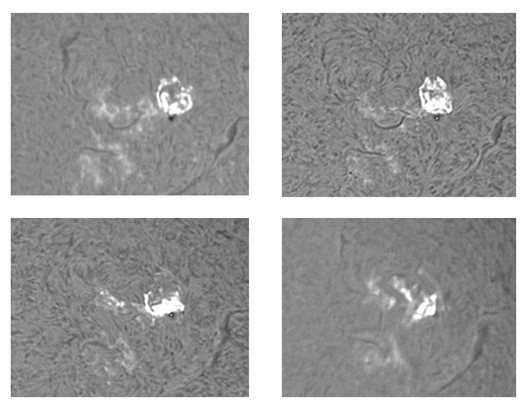
The first two M-class flares are similar, but not completely identical. For example, the surge from the first M2-flare is less pronounced and double. Also, the second M2-flare produced a faint Moreton wave (in H-alpha: a bright arc rapidly moving to the north), just as the much stronger X1-flare. All these differences may be due to changes in the magnetic field of the sunspot region, as can be seen in the mosaic underneath. Notice the similarity and subtle differences for the first two flares (top images), and the major changes in the delta region for the two other flares (bottom images).
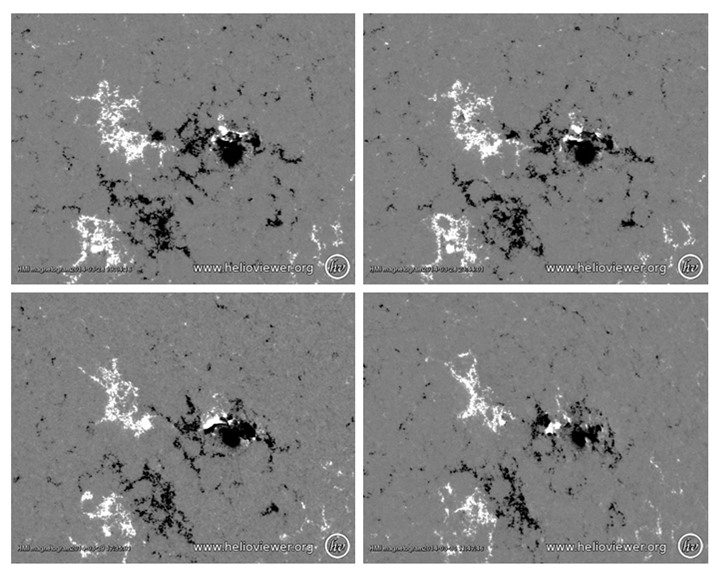
Over the years, the concept of "homology" has been extended to the flare-associated EIT-waves (see http://stce.be/news/241/welcome.html), coronal mass ejections (CME), and even radio-bursts. The movie at http://youtu.be/BQzkpfkGIJ4 first shows the white light and magnetic evolution of the sunspot group NOAA 2017, followed for each of the four events by the activity in H-alpha and EUV (overlaid on white light imagery), and ends by showing the associated EIT-waves and CMEs (difference images, i.e. only changes between two subsequent images are shown).
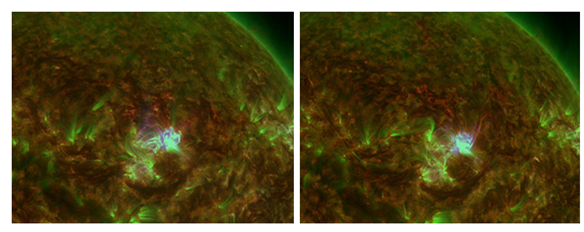
Credits - Imagery and data were taken from SDO (http://sdo.gsfc.nasa.gov/data/aiahmi/), GONG H-alpha Network (http://halpha.nso.edu/), SOHO (http://sohodata.nascom.nasa.gov/cgi-bin/data_query), PROBA2 (http://proba2.oma.be/ssa ), and (J)Helioviewer (http://helioviewer.org/).
The STCE Annual Report 2012 is now available at http://stce.be/annualreport.php
It is a compilation of the activities done in 2012 within the frame of the Solar-Terrestrial Centre of Excellence (STCE). This report continues the style from the previous edition. Hence, as it is targeting a more general public, it presents only a selection of the 2012-activities in easy-to-digest summaries. These summaries emphasize the intense collaboration between the institutes at the Space Pole, as well as with our external partners.
We hope you enjoy this report, which features articles on the evolution of the solar activity, the 9th European Space Weather Week, PROBA2, Integrated Water Vapor observations, SIMBA the nanosatellite, user applications such as STAFF, LIDAR, and ionospheric models, olympic disciplines for scientists and much more... Happy reading!
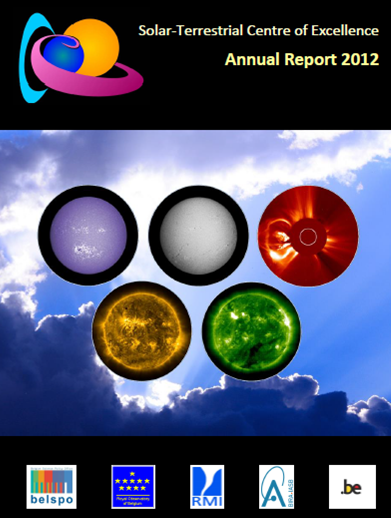
18-21 August 2014, Floreal Club Hotel, La Roche-en-Ardennes, Belgium
We are pleased to announce that registration and abstract submission are OPEN.
Please go to
http://www.stce.be/sipworkshop2014/registration.php
http://www.stce.be/sipworkshop2014/abstract.php
Students and early career post-doctoral researchers may apply for financial support at abstract submission.
The SIP workshop bring solar physics, statisticians and data processing expert together to discuss data analysis of solar missions and other joint topics of interest. The STCE welcomes all the participants with a drink and a bite on Sunday 17 August such that your energy level is optimal to start on Monday for the four days meeting with daily morning plenary sessions and afternoon splinters.
Power laws in solar physics: observations and proper estimation
Invited Speakers:
Prof. Clare Parnell (U. St Andrews): Power laws in solar physics
Prof. David Van Dyk (Imperial College): Bayesian paradigm for statistical inference of power laws
Optimal combination of in-situ and imaging data
How do we combine the information given by heterogenous data sets such as the one given by Solar Orbiter?
Invited Speakers:
Dr Christian Mostl (University of Graz): Combining HI and in situ observations to constrain CME evolution
Dr Tim Howard (SWRI): Tracking of CMEs and ICMEs through the heliosphere
How well can we predict solar eruptions (flares, CME arrival, SEP arrival) and geomagnetic disturbances?
Invited Speakers:
Dr Graham Barnes (NWRA): Physics behind flare prediction and current methods for flare forecasting
Prof. Pierre Dupont (U. catholique de Louvain): Machine learning in flare forecasting
Tracking of small scale magnetic features and its applications
What is the "best" way to track small scale features on the Sun, and how can we use this information to distinguish between different solar dynamo models?
Invited Speakers:
Dr Thomas Corpetti (U. Rennes) : Recent methods in tracking of small scale features
Origin of variability and prediction of solar wind
How can we predict solar wind conditions at Earth? What other data and analysis techniques do we need to better understand the solar wind?
Invited Speakers:
Prof. William Matthaeus (U. Delaware): Solar wind turbulence and the future missions
Solar Orbiter and Solar Probe Plus Dr Khurom Kiyani (U. Warwick): Analysing techniques in solar wind turbulence
More http://www.stce.be/sipworkshop2014/ .
The SIP workshop is organised by the Solar-Terrestrial Centre of Excellence.
22-23 May 2014, Meridian Room at ROB
The 2014 - international workshop - Physical processes in solar-terrestrial plasmas - is a successor and extended edition of the past STCE workshop series on Alfven waves and turbulence. In addition to the waves, turbulence, and related effects, this workshop will includes magnetic reconnection, plasma heating and acceleration, particles energization, and other physical processes crucial for solar-terrestrial connections. We aim to improve our understanding of basic physical processes driving space weather phenomena.
The final program will be distributed in the next announcement 29 April 1014. Please inform voitenko at oma.be and Andrei.Zhukov at oma.be before this date if you would like to give a presentation.
Info: http://stce.be/annualmeeting/2014/waves.php
P.S. Brain calories (i.e. lunch) are foreseen on both days.
Solar flare activity fluctuated between low and high during the week.
In order to view the activity of this week in more detail, we suggest to go to the following website from which all the daily (normal and difference) movies can be accessed: http://proba2.oma.be/ssa
This page also lists the recorded flaring events.
A weekly overview movie can be found here (SWAP week 209).
http://proba2.oma.be/swap/data/mpg/movies/WeeklyReportMovies/WR209_Mar24_Mar30/weekly_movie_2014_03_24.mp4
Details about some of this week's events, can be found further below.
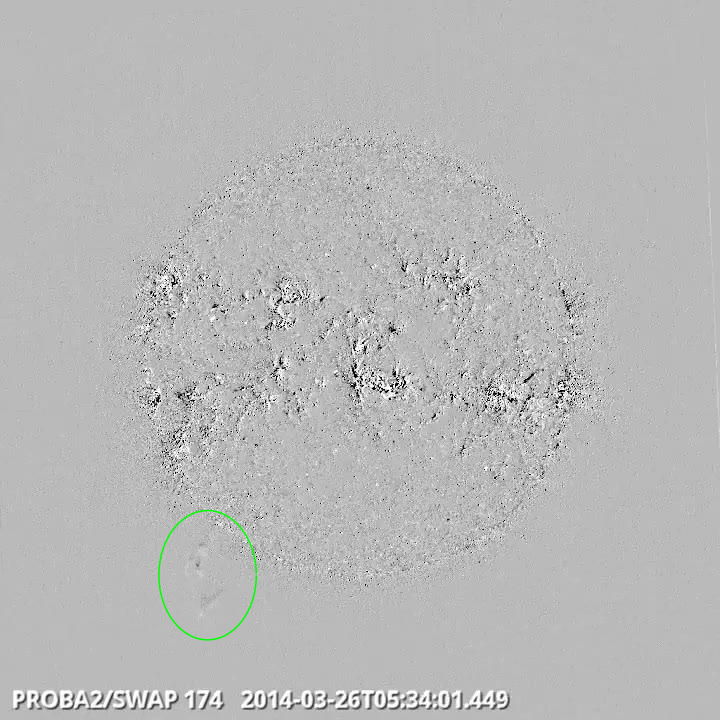
Eruption on the southeast limb @ 05:34 SWAP difference image
Find a movie of the event here (SWAP daily difference movie)
http://proba2.oma.be/swap/data/mpg/movies/20140326_swap_diff.mp4
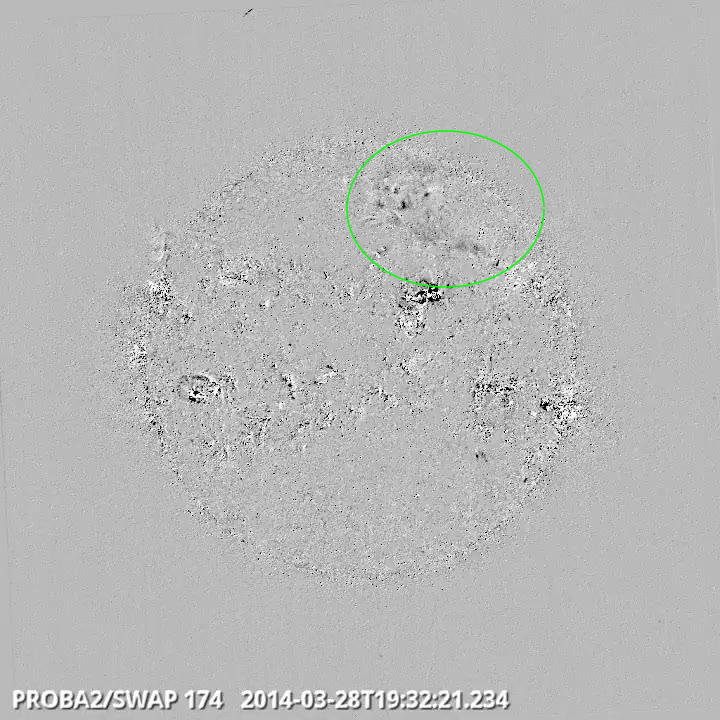
EIT wave on the northwest quad @ 19:32 SWAP difference image
Find a movie of the event here (SWAP daily difference movie)
http://proba2.oma.be/swap/data/mpg/movies/20140328_swap_diff.mp4
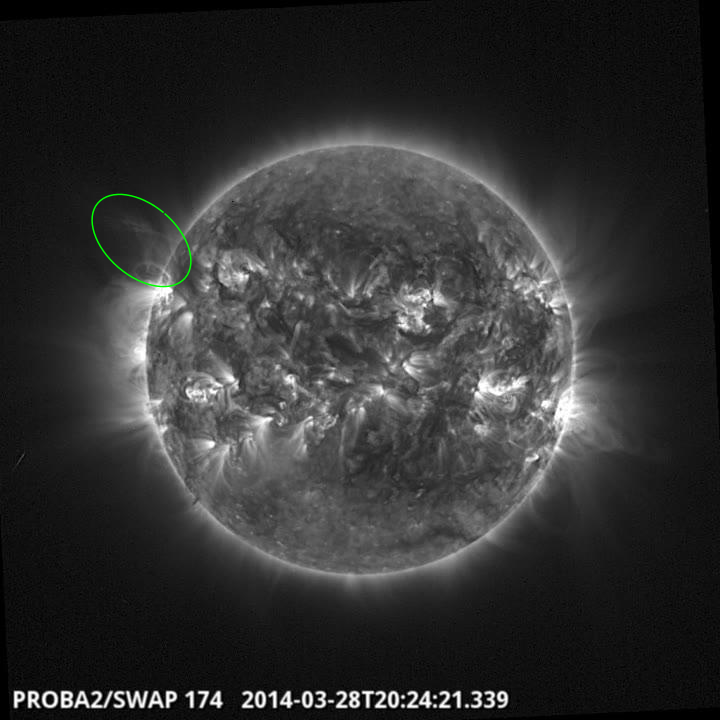
Eruption on the northeast limb @ 20:24 SWAP image
Find a movie of the event here (SWAP daily movie)
http://proba2.oma.be/swap/data/mpg/movies/20140327_swap_movie.mp4
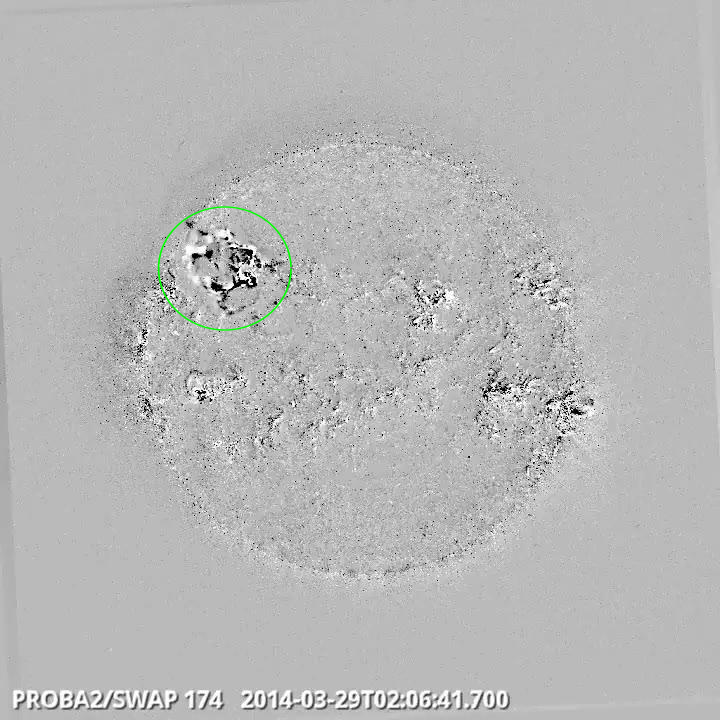
Eruption on the northeast quad @ 02:06 SWAP difference image
Find a movie of the event here (SWAP daily movie)
http://proba2.oma.be/swap/data/mpg/movies/20140329_swap_movie.mp4
Find a movie of the event here (SWAP daily diffrence movie)
http://proba2.oma.be/swap/data/mpg/movies/20140329_swap_diff.mp4
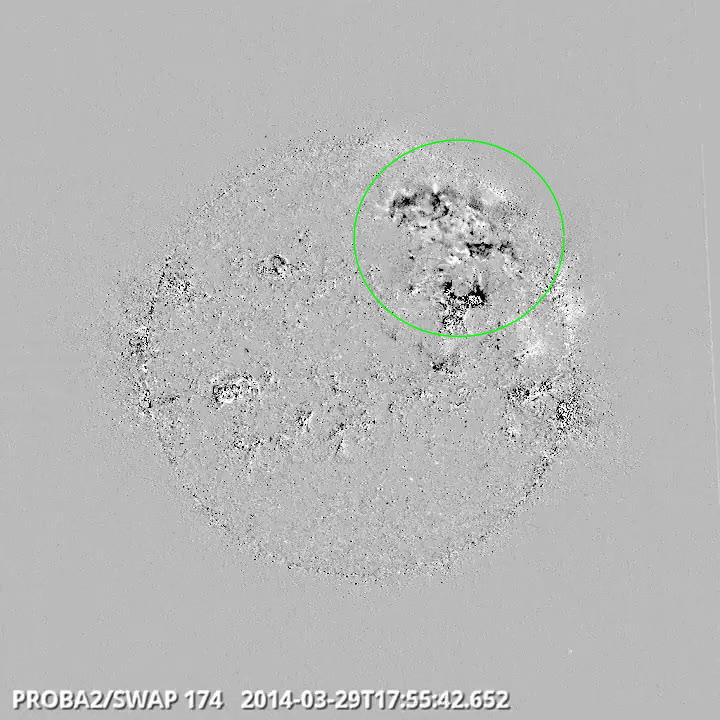
EIT wave on the northwest quad @ 17:55 SWAP difference image
Find a movie of the event here (SWAP daily difference movie)
http://proba2.oma.be/swap/data/mpg/movies/20140329_swap_diff.mp4
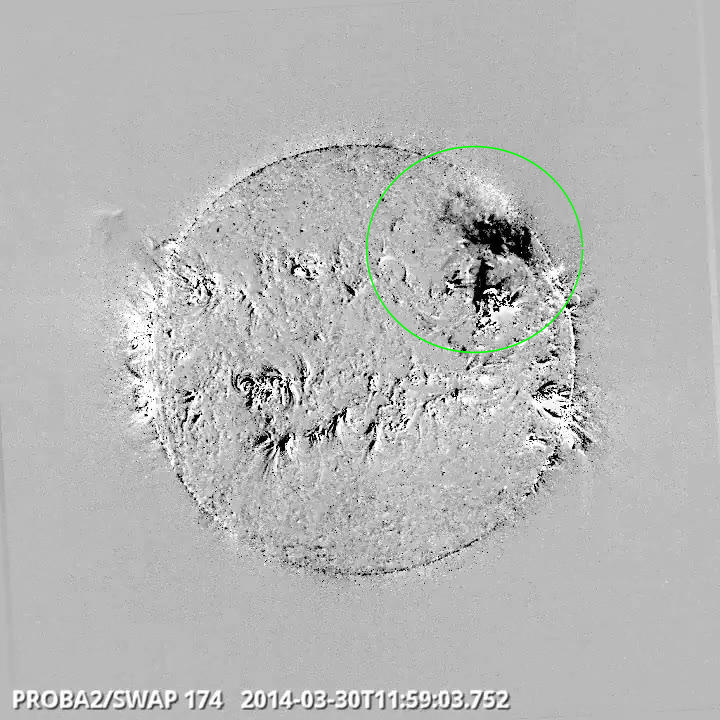
EIT wave on the northwest quad @ 11:59 SWAP difference image
Find a movie of the event here (SWAP daily difference movie)
http://proba2.oma.be/swap/data/mpg/movies/20140330_swap_diff.mp4
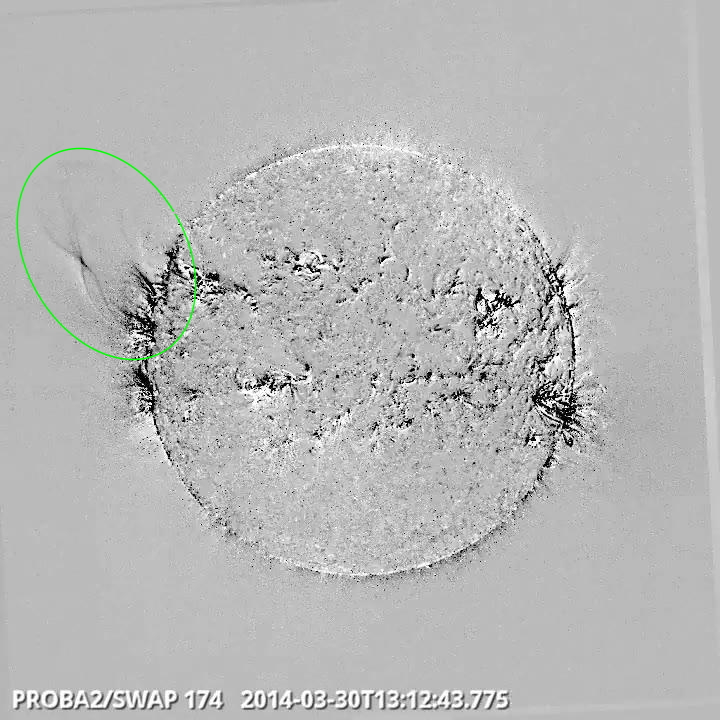
Eruption on the northeast limb @ 13:12 SWAP difference image
Find a movie of the event here (SWAP daily movie)
http://proba2.oma.be/swap/data/mpg/movies/20140330_swap_movie.mp4
Find a movie of the event here (SWAP daily diffrence movie)
http://proba2.oma.be/swap/data/mpg/movies/20140330_swap_diff.mp4
Solar activity was driven by C-class flares from NOAA ARs 2010, 2014 and 2015, from March 24 until March 28. On March 28, NOAA AR 2017 produced an M2.0 flare with peak at 19:18 UT and an M2.6 flare peaking at 23:51 UT. They were associated with two front-sided halo CMEs. The first one with a speed of around 400km/s (first seen by LASCO-C2 at 20:00 UT) and the second one around 550 km/s (at 23:58 UT). A back-sided full halo CME was seen by LASCO-C2 shortly before, at 16:56 UT. NOAA AR 2017 (beta gamma delta magnetic field configuration) released then an X1.0 flare with peak at 17:48 UT on March 29, associated with radio bursts, a full halo CME and an increase in GOES proton fluxes (not passing the threshold). This full halo CME was first seen at 18:12 UT by LASCO-C2 and had a speed around 500 km/s. On March 30, NOAA AR 2017 released an M2.1 peaking at 11:55 UT. It was associated with a partial halo CME, first visible in the LASCO-C2 field of view at 12:24 UT. The CME had an angular width of about 170 degrees and a speed of around 500 km/s (as determined by the CACTUS software).
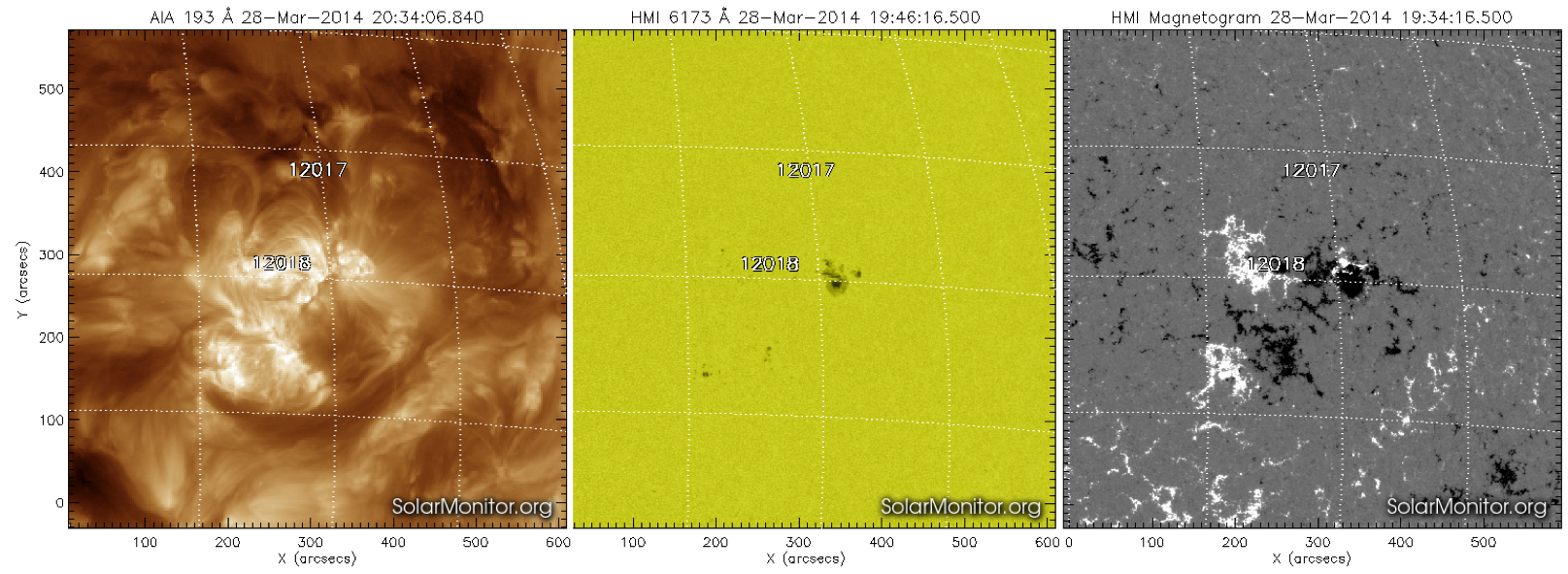
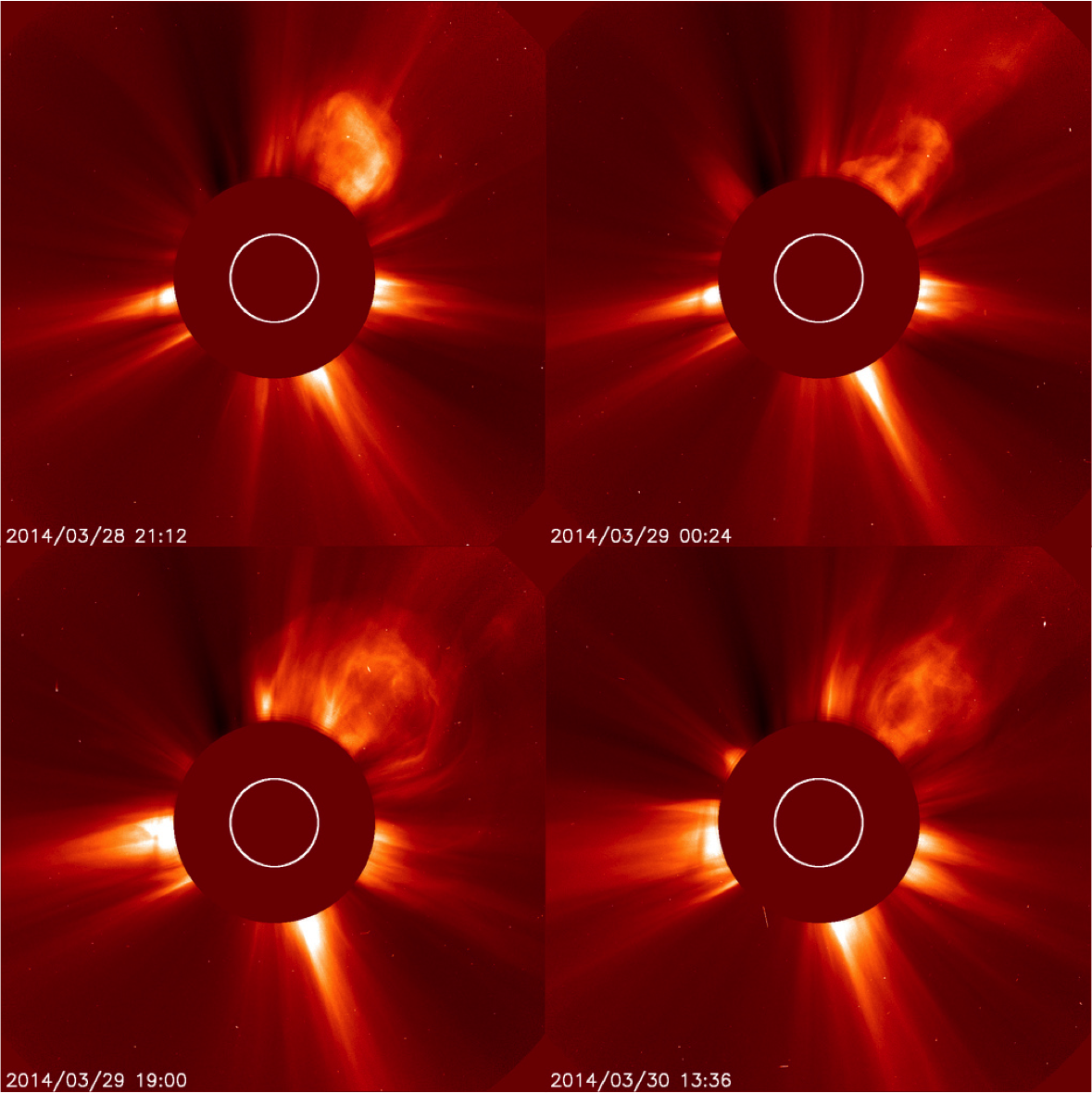
In the SDO/AIA 193 movie, 4 EUV-waves centralised around NOAA AR 2017 are visible at the time of the M- and X-flares. An EUV wave is an on disk indication of the ejection of coronal plasma. The difference movies are made from images taken by LASCO/C2 onboard of SOHO.
Check the movies:
http://www.stce.be/movies/20140328_aia_193.mp4
http://www.stce.be/movies/20140328_dc2.mpg
http://www.stce.be/movies/20140329_dc2.mpg
http://www.stce.be/movies/20140330_dc2.mpg
Geomagnetic conditions were quiet until the arrival of a shock corresponding to a CME from March 23 - see the SoHO/CELIAS/MTOF graph. This occurred on March 25 at 19:25 UT, and geomagnetic conditions reached active levels. Quiet to unsettled conditions were experienced for the rest of the week.
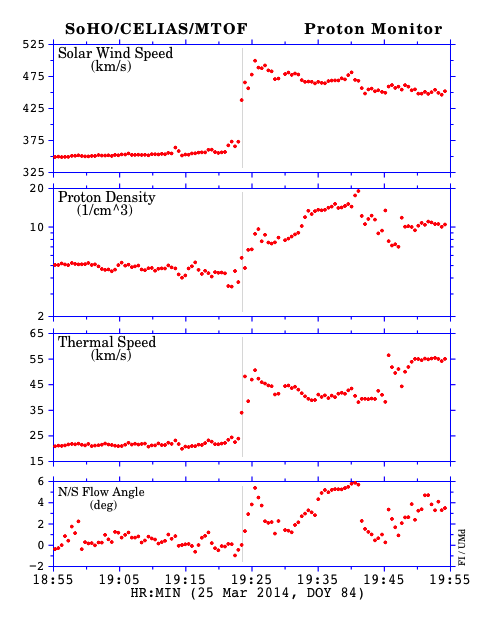
| DAY | BEGIN | MAX | END | LOC | XRAY | OP | 10CM | TYPE | Cat | NOAA |
| 28 | 1904 | 1918 | 1927 | N11W21 | M2.0 | SN | V/2II/2 | 98 | 2017 | |
| 28 | 2344 | 2351 | 2358 | M2.6 | II/2 | 98 | 2017 | |||
| 29 | 1735 | 1748 | 1754 | N11W32 | X1.0 | 2B | 360 | III/3II/3 | 98 | 2017 |
| 30 | 1148 | 1155 | 1202 | N8W43 | M2.1 | 1N | 120 | III/2II/2 | 98 | 2017 |
| LOC: approximate heliographic location | TYPE: radio burst type |
| XRAY: X-ray flare class | Cat: Catania sunspot group number |
| OP: optical flare class | NOAA: NOAA active region number |
| 10CM: peak 10 cm radio flux |

The figure shows the time evolution of the Vertical Total Electron Content (VTEC) (in red) during the last week at three locations:
a) in the northern part of Europe(N61°, 5°E)
b) above Brussels(N50.5°, 4.5°E)
c) in the southern part of Europe(N36°, 5°E)
This figure also shows (in grey) the normal ionospheric behaviour expected based on the median VTEC from the 15 previous days.
The VTEC is expressed in TECu (with TECu=10^16 electrons per square meter) and is directly related to the signal propagation delay due to the ionosphere (in figure: delay on GPS L1 frequency).
The Sun's radiation ionizes the Earth's upper atmosphere, the ionosphere, located from about 60km to 1000km above the Earth's surface.The ionization process in the ionosphere produces ions and free electrons. These electrons perturb the propagation of the GNSS (Global Navigation Satellite System) signals by inducing a so-called ionospheric delay.
See http://stce.be/newsletter/GNSS_final.pdf for some more explanations ; for detailed information, see http://gnss.be/ionosphere_tutorial.php
Start : 2014-04-27 - End : 2014-05-02
The EGU General Assembly 2014 will bring together geoscientists
from all over the world to one meeting covering all disciplines of
the Earth, planetary and space sciences. The EGU aims to provide a
forum where scientists, especially early career researchers, can
present their work and discuss their ideas with experts in all
fields of geosciences.
Start : 2014-06-10 - End : 2014-06-11
The STCE workshop 'Inter-Calibration and Degradation of EUV
Instruments' aims at understanding the differences observed between
the various instruments observing in the SXR-EUV range and at
analyzing the ageing effects that affect their results. It targets
imagers as well as spectrometers and photometers.
The workshop will be followed by two days of working sessions
(June 12-13) organized by the Solar EUV Irradiance Working Group
(also supported by the STCE). These working sessions are in the
continuity of similar events organized in 2011, 2012 and 2013, but
they are open to new participants and you are welcome to join if
you are interested.
Website:
http://www.stce.be/euvworkshop2014/
Start : 2014-06-19 - End : 2014-06-20
During the summer of 2014 DTU Space will host the 3rd Swarm
Science Meeting, sponsored by the European Space Agency, ESA
. This meeting will take place at
the IDA Conference Centre in Copenhagen on June 19th to 20th 2014
and is open to the science community at large.
Website:
http://congrexprojects.com/2014-events/Swarm/home
http://www.spaceweather.eu/en/repository/show?id=491
http://www.spaceweather.eu/en/repository/show?id=492
http://www.spaceweather.eu/en/repository/show?id=493
The STCE Annual Report 2012 is a compilation of the activities done in 2012 within the frame of the Solar-Terrestrial Centre of Excellence (STCE). This report continues the style from the previous edition. Hence, as it is targeting a more general public, it presents only a selection of the 2012-activities in easy-to-digest summaries. These summaries emphasize the intense collaboration between the institutes at the Space Pole, as well as with our external partners. We hope you enjoy this report, which features articles on the evolution of the solar activity, the 9th European Space Weather Week, PROBA2, Integrated Water Vapor observations, SIMBA the nanosatellite, user applications such as STAFF, LIDAR, and ionospheric models, and much more... Happy reading!
http://www.spaceweather.eu/en/repository/show?id=494